Animals at KFBG – The Life Journey of Two Rescued Leopard Cats
The Leopard Cat (Prionailurus bengalensis) is a native wild cat under the Felidae family. Although it is widely distributed in Hong Kong, sightings of Leopard Cats are quite uncommon. This may be due to their nocturnal habits. Most Hong Kong citizens will never have a chance to see this beautiful but mysterious local species. However, if you have had the chance to visit Kadoorie Farm and Botanic Garden (KFBG), you may have noticed our two resident Leopard Cats on display at the Native Mammal House. Their rescue stories help to raise awareness of animal conservation and protection.
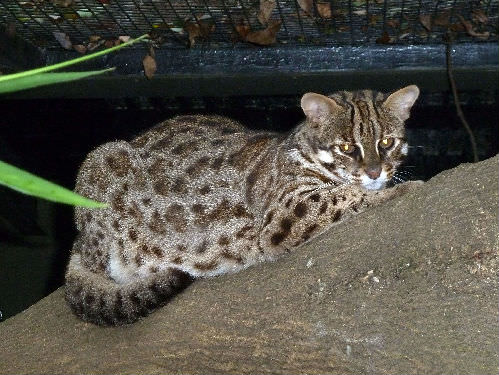
One of the Leopard Cats resting on a hanging log at the Native Mammal Display (photo taken in 2012)
Rescued in early 2000s
Both Leopard Cats were handed over to the Wild Animal Rescue Centre (WARC) between 2000 and 2001. One of the kittens was seized by the Authorities at the border on 3 October 2000. It was being smuggled into China for the illegal pet market. The kitten’s condition upon arrival at KFBG was poor, it had a respiratory infection and tongue ulcerations. Happily, after a year of rehabilitation and veterinary treatment, it recovered and joined our live education displays in 2001.
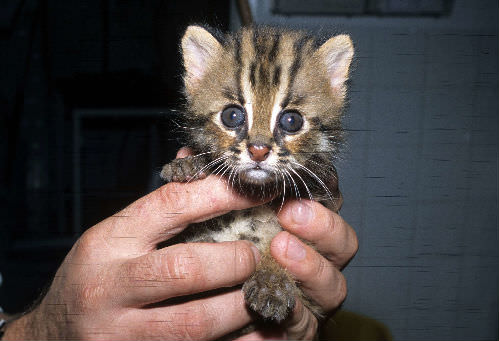
A rescued Leopard Cat kitten in 2000
The other Leopard Cat kitten was found in Mai Po after a rainstorm on 10 April 2001. It was very young and required hand rearing. After long discussions and thorough planning, the Rescue Team decided to hand rear the kitten, with the plan to keep it in captivity for education purposes. In 2003, this cat joined the other at the Native Mammal Display.
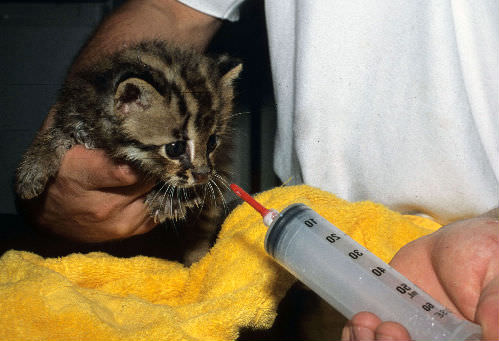
Staff hand-feeding a Leopard Cat kitten
Life at KFBG
Keeping wild animals in captivity is only ever considered as a last resort and is not an easy task. The Live Education Display team takes care of all long term captive display animals and makes sure to develop enclosures that are appropriate for animals to carry out natural behaviours in a setting that is as close to their natural habitat as possible in captivity.
Diet: Leopard Cats are carnivores. In the wild, they hunt for frogs, lizards, birds and small mammals. In captivity, we provide them with a large range of food choices, making sure to include dead whole prey items such as small rodents and chicks, as well as chicken, beef and fish.
Enclosure Design: The enclosure is designed to keep the cats healthy, both physically and mentally. There is an indoor shelter, natural hiding areas, a large pool and climbing structures. The Native Mammal Display was upgraded in 2012 to give them a more dynamic living environment, incorporating moving branches and special feeders for enrichment.
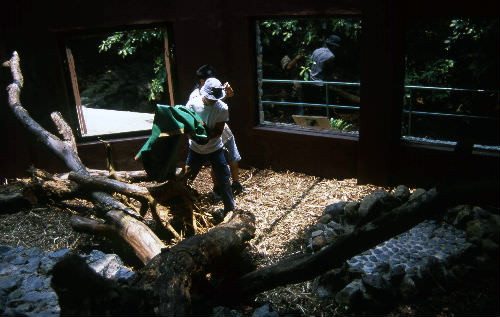
Construction of the Native Mammal Display in early 2000s
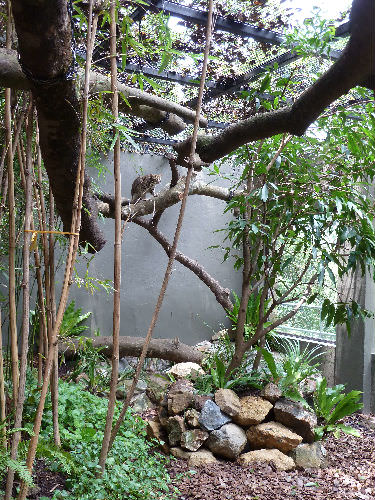
Redeveloped Native Mammal Display in 2012
Cat Habits: Being nocturnal animals, the cats are more active at night than during the day. You may spot them resting on tree branches or among the plantings on the ground during the day. Leopard Cats are extremely agile and have no problems getting up and down trees and branches.
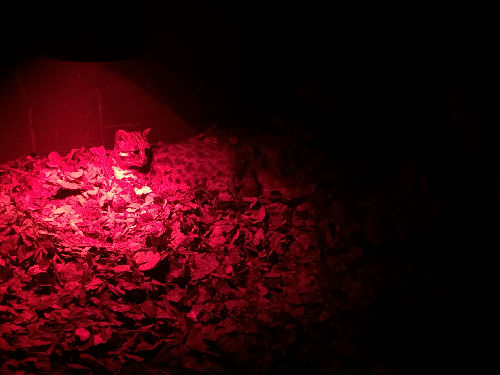
A Leopard Cat resting under a heat lamp during winter
Both animals have lived at the Native Mammal House for more than 10 years. Leopard Cats have an average lifespan of about 4 years in the wild and a small number live up to 20 years in captivity. Our Leopard Cats are more than 14 years old and for this species, this is considered old. They are a lot less active now, their movements are slower and they are not as strong as they used to be. The Veterinary Team is monitoring their health status closely.
Illegal fur and pet trade
Although the wild population of Leopard Cats is considered to be quite healthy in the region, Leopard Cat pelts are commercially traded and used in the fashion industry (average 200,000 per year in the late 1980s) (Nowell and Jackson 1996). Wild Leopard Cats are sometimes kept as pets despite this being illegal. Breeders keep these animals in captivity to interbreed with domestic cats to produce hybrid offspring called Bengal Cats for the pet trade. The Leopard Cat is listed as CITES Appendix I in Bangladesh, India and Thailand and Appendix II in other countries. In Hong Kong, it is protected under the Wild Animals Protection Ordinance Cap 170.
What can you do to help protect Leopard Cats?
Do not support the illegal trade and do not buy Leopard Cat fur or keep Leopard Cats as pets. Help by reporting suspected illegal wildlife trade activities to AFCD at (852) 2150 6978 or KFBG hotline at (852) 2483 7200. Help to keep the populations of this fascinating animal healthy in the wild.

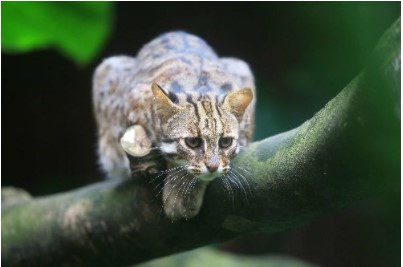
Come visit the Leopard Cats, one of KFBG’s live attractions, at the Native Mammal Display. (photo taken in 2008)

